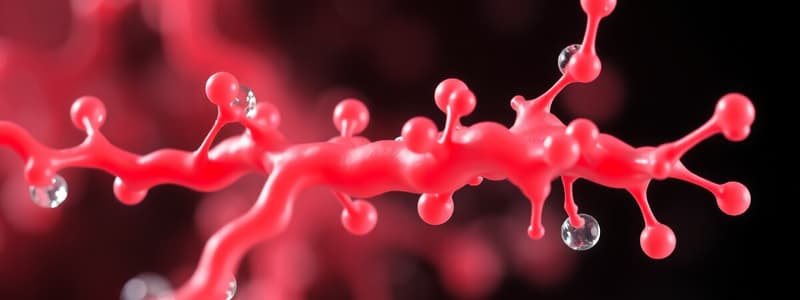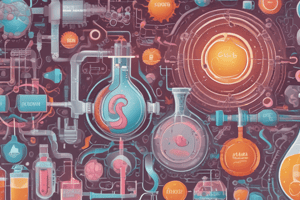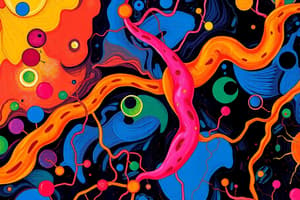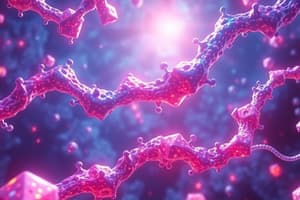Podcast
Questions and Answers
Why is having a constant source of glucose critically important for human life?
Why is having a constant source of glucose critically important for human life?
- It is the primary energy source for the brain.
- It is essential for cells with no or few mitochondria.
- It is the essential energy source for exercising muscles.
- All of the above. (correct)
In what form is excess glucose stored within the liver and skeletal muscles?
In what form is excess glucose stored within the liver and skeletal muscles?
- Bound to transport proteins.
- As fatty acids.
- As glycogen. (correct)
- As free glucose molecules.
During fasting, why is liver glycogen degraded?
During fasting, why is liver glycogen degraded?
- To provide energy for muscle contraction.
- To produce ATP in the liver.
- To maintain blood glucose levels. (correct)
- To synthesize amino acids.
How does glycogen's branched structure contribute to its function?
How does glycogen's branched structure contribute to its function?
What type of glycosidic bonds are formed by glycogen synthase during glycogen synthesis?
What type of glycosidic bonds are formed by glycogen synthase during glycogen synthesis?
What role does the branching enzyme play in glycogen synthesis?
What role does the branching enzyme play in glycogen synthesis?
During glycogen synthesis, what is the role of UDP-glucose?
During glycogen synthesis, what is the role of UDP-glucose?
What is the function of glycogenin in glycogenesis?
What is the function of glycogenin in glycogenesis?
What is the primary product of glycogen phosphorylase activity?
What is the primary product of glycogen phosphorylase activity?
What two enzymes are required for the debranching process in glycogenolysis?
What two enzymes are required for the debranching process in glycogenolysis?
Why is pyridoxal phosphate (PLP) important for the activity of glycogen phosphorylase?
Why is pyridoxal phosphate (PLP) important for the activity of glycogen phosphorylase?
What is the role of phosphoglucomutase in glycogen metabolism?
What is the role of phosphoglucomutase in glycogen metabolism?
Which of the following best describes the regulation of glycogen metabolism?
Which of the following best describes the regulation of glycogen metabolism?
How does insulin influence glycogen metabolism?
How does insulin influence glycogen metabolism?
What effect does glucagon have on glycogen metabolism in the liver?
What effect does glucagon have on glycogen metabolism in the liver?
How does epinephrine affect glycogen metabolism in muscles?
How does epinephrine affect glycogen metabolism in muscles?
What role does cAMP play in the hormonal regulation of glycogen metabolism?
What role does cAMP play in the hormonal regulation of glycogen metabolism?
Why is calcium important in regulating glycogen phosphorylase in muscle cells?
Why is calcium important in regulating glycogen phosphorylase in muscle cells?
In the context of glycogen storage diseases, what is a general consequence of these disorders?
In the context of glycogen storage diseases, what is a general consequence of these disorders?
In Von Gierke's disease (Type I glycogen storage disease), which enzyme is deficient?
In Von Gierke's disease (Type I glycogen storage disease), which enzyme is deficient?
Which enzyme is deficient in Cori's disease (Type III glycogen storage disease)?
Which enzyme is deficient in Cori's disease (Type III glycogen storage disease)?
What type of glycosidic bond is cleaved by glycogen phosphorylase?
What type of glycosidic bond is cleaved by glycogen phosphorylase?
What is the primary function of liver glycogen?
What is the primary function of liver glycogen?
Which of the following statements correctly describes the relationship between glycogen synthase and branching enzyme in glycogenesis?
Which of the following statements correctly describes the relationship between glycogen synthase and branching enzyme in glycogenesis?
How does the allosteric regulation of glycogen phosphorylase differ between the liver and muscle?
How does the allosteric regulation of glycogen phosphorylase differ between the liver and muscle?
What is the role of UDP-glucose pyrophosphorylase in the context of glycogen synthesis?
What is the role of UDP-glucose pyrophosphorylase in the context of glycogen synthesis?
Which of the following hormones primarily increases glycogenolysis in both liver and muscle?
Which of the following hormones primarily increases glycogenolysis in both liver and muscle?
How does the epinephrine signaling pathway promote glycogenolysis?
How does the epinephrine signaling pathway promote glycogenolysis?
In McArdle's disease (Type V glycogen storage disease), which tissue is primarily affected, and what is the deficient enzyme?
In McArdle's disease (Type V glycogen storage disease), which tissue is primarily affected, and what is the deficient enzyme?
In liver cells, what is the immediate fate of glucose-6-phosphate produced from glycogenolysis, and how does this differ in muscle cells?
In liver cells, what is the immediate fate of glucose-6-phosphate produced from glycogenolysis, and how does this differ in muscle cells?
What is the effect of increased cytosolic calcium levels on glycogen metabolism in muscle cells?
What is the effect of increased cytosolic calcium levels on glycogen metabolism in muscle cells?
How does phosphorylation typically affect the activity of glycogen phosphorylase and glycogen synthase?
How does phosphorylation typically affect the activity of glycogen phosphorylase and glycogen synthase?
How does the deficiency of lysosomal α-1,4-glucosidase in Pompe disease lead to glycogen accumulation?
How does the deficiency of lysosomal α-1,4-glucosidase in Pompe disease lead to glycogen accumulation?
Which of the following is a key difference between how muscle and liver glycogen metabolism contribute to overall glucose homeostasis?
Which of the following is a key difference between how muscle and liver glycogen metabolism contribute to overall glucose homeostasis?
How does the well-fed state affect glycogen stores in the liver, and which hormone mediates this change?
How does the well-fed state affect glycogen stores in the liver, and which hormone mediates this change?
Which enzyme is responsible for transferring a segment of a growing glycogen chain to create a branch point?
Which enzyme is responsible for transferring a segment of a growing glycogen chain to create a branch point?
What conditions favor the activation of glycogen phosphorylase in muscle?
What conditions favor the activation of glycogen phosphorylase in muscle?
How does the role of glucagon in regulating glycogen metabolism differ between the liver and muscle?
How does the role of glucagon in regulating glycogen metabolism differ between the liver and muscle?
What is the impact of epinephrine on liver glycogen during a 'fight or flight' response?
What is the impact of epinephrine on liver glycogen during a 'fight or flight' response?
What is a primary consequence of a deficiency in the enzyme phosphorylase kinase?
What is a primary consequence of a deficiency in the enzyme phosphorylase kinase?
Which hormone promotes the dephosphorylation of glycogen synthase, leading to its activation?
Which hormone promotes the dephosphorylation of glycogen synthase, leading to its activation?
What is the role of calcium-calmodulin complex in the activation of glycogen phosphorylase?
What is the role of calcium-calmodulin complex in the activation of glycogen phosphorylase?
For an individual with Andersen's disease (Type IV glycogen storage disease) which of the following enzymes would be deficient?
For an individual with Andersen's disease (Type IV glycogen storage disease) which of the following enzymes would be deficient?
Flashcards
Glycogenesis
Glycogenesis
The synthesis of glycogen from glucose molecules.
Glycogenolysis
Glycogenolysis
The degradation of glycogen to release glucose.
Glycogen
Glycogen
A highly branched polymer of D-glucose.
Glycogen Synthase
Glycogen Synthase
Signup and view all the flashcards
Debranching Enzyme
Debranching Enzyme
Signup and view all the flashcards
Glycogen Phosphorylase
Glycogen Phosphorylase
Signup and view all the flashcards
Allosteric Regulation
Allosteric Regulation
Signup and view all the flashcards
Glycogenolysis
Glycogenolysis
Signup and view all the flashcards
Glycogenesis
Glycogenesis
Signup and view all the flashcards
Gluconeogenesis
Gluconeogenesis
Signup and view all the flashcards
Liver Glycogen
Liver Glycogen
Signup and view all the flashcards
Glycogen Primer
Glycogen Primer
Signup and view all the flashcards
Insulin's Role
Insulin's Role
Signup and view all the flashcards
Hormonal Control
Hormonal Control
Signup and view all the flashcards
Glycogen Phosphorylase
Glycogen Phosphorylase
Signup and view all the flashcards
Glycogenolysis
Glycogenolysis
Signup and view all the flashcards
Glycogen Degradation
Glycogen Degradation
Signup and view all the flashcards
Phosphoglucomutase
Phosphoglucomutase
Signup and view all the flashcards
Glucose-6-Phosphatase rxn
Glucose-6-Phosphatase rxn
Signup and view all the flashcards
Hormonal Influence
Hormonal Influence
Signup and view all the flashcards
Glycogen Phosphorylase Forms
Glycogen Phosphorylase Forms
Signup and view all the flashcards
Calcium's Role
Calcium's Role
Signup and view all the flashcards
Glycogen Storage Diseases
Glycogen Storage Diseases
Signup and view all the flashcards
Von Gierke
Von Gierke
Signup and view all the flashcards
Pompe
Pompe
Signup and view all the flashcards
Cori
Cori
Signup and view all the flashcards
Anderson
Anderson
Signup and view all the flashcards
McArdle
McArdle
Signup and view all the flashcards
Hers
Hers
Signup and view all the flashcards
Study Notes
- The lecture is about Glycogen Metabolism
- Lecture number 8
Key Topics
- Glycogenesis (Glycogen synthesis)
- Glycogenolysis (Glycogen degradation)
- Glycogen metabolism regulation (hormonal, allosteric)
- Glycogen storage diseases
Importance of Glucose
- A constant supply of glucose is essential for human life for different reasons
- The brain needs glucose as its primary energy source
- Cells lacking mitochondria, like RBCs, rely on glucose
- Exercising muscles require glucose as a primary energy source
Sources of Glucose
- Humans obtain glucose from three main sources
- Carbohydrates in diet provide glucose after meals and Excess glucose is stored as glycogen in the liver and skeletal muscles
- Glycogen degradation (Glycogenolysis): Glycogen is broken down to release glucose stored in the liver and skeletal muscles
- In fasting liver glycogen degrades to yield glucose for blood
- During exercise, glycogen is degraded in muscles to supply glucose for energy
- Gluconeogenesis (Glucose Synthesis): Synthesis of glucose from non-carbohydrate sources which occurs in prolonged fasting
Glycogen Structure and Function
- The liver (100 g) and skeletal muscles (400 g) serve as the main storage sites for glycogen.
- Glycogen in muscles provides glucose for ATP and energy
- Glycogen in the liver maintains blood glucose levels
- Storing glucose of glycogen prevents excess glucose as free glucose
Regulation of Glycogen Stores
- Liver glycogen stores increase in a well-fed state and decrease during fasting
- Muscle glycogen is not affected by short periods of fasting
- Muscle glycogen is moderately decreased in prolonged fasting and affected by exercise
Glycogen Structure in Detail
- Glycogen is a highly branched polymer of D-glucose with branching every 8-14 residues
- Chains of glucose have glycosidic links: α(1→4) linkages and α(1→6) linkages where branches occur
- Highly branched structure leads to more solubility and increases rates of degradation/ synthesis
- Glycogen molecules can contain up to 50,000 residues
Glycogenesis
- Glycogenesis is the process of glucose storage as glycogen.
- Glycogenesis is a 4 step process activated by insulin in the liver or skeletal muscle.
Glycogenolysis
- Glycogen is broken down for glucose release, not a simple reversal of steps
- Enzyme phosphorylase splits off a glucose molecule by phosphorylation to form glucose 1-phosphate.
- This process occurs in hepatocytes, therefore muscles can't release glucose.
- Activating enzymes are glucagon (pancreas) and epinephrine (adrenal).
Glycogen Formation
- UDP-glucose pyrophosphorylase is formation of new glycogen or enlargement of existing glycogen particle
- Glycogen synthase (elongation) catalyzes α1-4 linkages
- Branching enzyme (branching) amylo-α(1-4) converts to α(1-6)
- Glycogenin is required in formation of glycogen
Glycogenesis Steps using Enzymes
- Glucose is converted to glucose-6-phosphate by hexokinase in muscles or Glucokinase in liver.
- Glucose-6-phosphate converts to glucose-1-phosphate by Phosphoglucomutase.
- Glucose-1-phosphate is used by UDP-glucose pyrophosphatase to create UDP-glucose
- UDP- glucose is used by Glycogen synthase or Branching enzyme to create glycogen
Glycogenesis Overview
- A sequence of adding UDP-glucose to glycogen's non-reducing ends occurs via sequential addition
- Mechanisms for Chain Elongation happens when glucose α(1,4) joins
- Branch Formation happens when glucose α(1,6) joins
- Branching enzymes creates α(1,6) bonds
- Glycogen synthase creates α(1,4) bonds
Detailed Enzyme Reactions
- Glucose to Glucose-6-phosphate: ΔG =-16.7 kJ/mol
- UDP formation has a "primer" to imitate glycogenesis
- A small fragment of pre-existing glycogen acts as a 'primer’ to begin glycogen synthesis
- Glycogenin accepts a specific protein to accept glucose from UDP Glucose
- The hydroxyl (OH) of the amino acid tyrosine of glycogenin is the site where the initial glucose unit attaches.
- The glycogen chain adds one glucose residue via UDP-glucose + glycogen (n) ⟶ glycogen (n+1) + UDP
- Branching enzymes catalyze glycogen formation branching via amylo-(1→4→1,6)-transglycosylase (also called branching enzyme)
- α-(1→6) linkages occur every 8-12 residues
- The branching enzymes transfer 6- or 7-residue segments nonreducing end.
Glycogenolysis
- Glycogenolysis is the breakdown of stored glycogen in liver and muscle facilitated by enzymes in cytosol
- Glycogen synthesis and degradation are not reversible
- Breaking α-1,4 and α-1,6 Glycosidic bonds degrades glycogen
Glycogen Phosphorylase
- Catalyzes phosphorolysis and requires Pyridoxal phosphate (PLP), a prosthetic group for activity
- Relays a proton from inorganic phosphates and substrate phosphate to help cleave the scissile bond of Glyocogen.
- Glycogen phosphorylase uses inorganic phosphates and glycogen as substrates in a reaction that produces G1P.
Glycogen Phosphorylase Mechanism
- Phosphorylase follows a “random sequential” enzyme mechanism involving PLP (pyridoxyl-5’-phosphate), a B6 derivative.
- Debranching uses glucan transferase and also debranching enzyme (alpha-1,6-glucosidase)
- Branching is hydrolyzed, releasing branched glucose reside as free glucose
- After the branch removal, phosphorylase enzyme is used
- Phosphoglucomutase catalyzes G1P to glucose 6-phosphate (G6P)
Steps of Glycogenolysis
- Glycogen --> Glycogen phosphorylase-->α(1→4)→α(1→4)-glucan transferase--> Amylo-α(1→6)-glucosidase--> Glucose 1-phosphate
- Glucose l-phosphate -->Phosphoglucomutase-->Glucose 6-phosphate
- Glucose 6-phosphate in Muscle
- Phosphatase --> Glucose in Liver
Regulation of Glycogenesis and Glycogenolysis
- Regulated by the enzymes glycogen synthase and Glycogen phosphorylase using three mechanisms
- Allosteric Regulation
- Hormonal Regulation
- Influence of Calcium
Hormonal Regulation
- Hormones like epinephrine and glucagon cause glycogenolysis by acting on glycogen phosphorylase through cAMP.
- Glycogen phosphorylase has two forms: Active ‘a’ form (phosphorylated) and Inactive form ‘b’ (dephosphorylated)
- Glycogen synthase (inactive form) is in inhibited in glycogenesis
- Glycogen phosphorylase is stimulates glycogenolysis in its active form
Regulation of Glycogen Breakdown
- Muscle contraction needs Ca2+-calmodulin complex activation in α1-adrenergic receptors.
- Ca2+-dependent enzymes activate,like e.g., glycogen phosphorylase kinase
- Glycogen phosphorylase kinase phosphorylates which leads to activates calcium and in turn glycogen phosphorylase
- Epinephrine activates glycogen degradation via a rise in cAMP, not Ca2+.
Glycogen Storage Diseases
- Type I:Von Gierke has Deficient Enzyme of Glucose -6- Phosphate
- Type II: Pompe has Deficient Enzyme of Lysosomal α 1,4 glycosidase
- Type III: Cori has Deficient Enzyme of Debranching Enzyme
- Type IV: Anderson has Deficient Enzyme of Branching Enzyme
- Type V: McArdle has Deficient Enzyme of Muscle Glycogen Phosphorylase
- Type VI: Hers has Deficient Enzyme of Hepatic Glycogen Phosphorylase
Studying That Suits You
Use AI to generate personalized quizzes and flashcards to suit your learning preferences.



